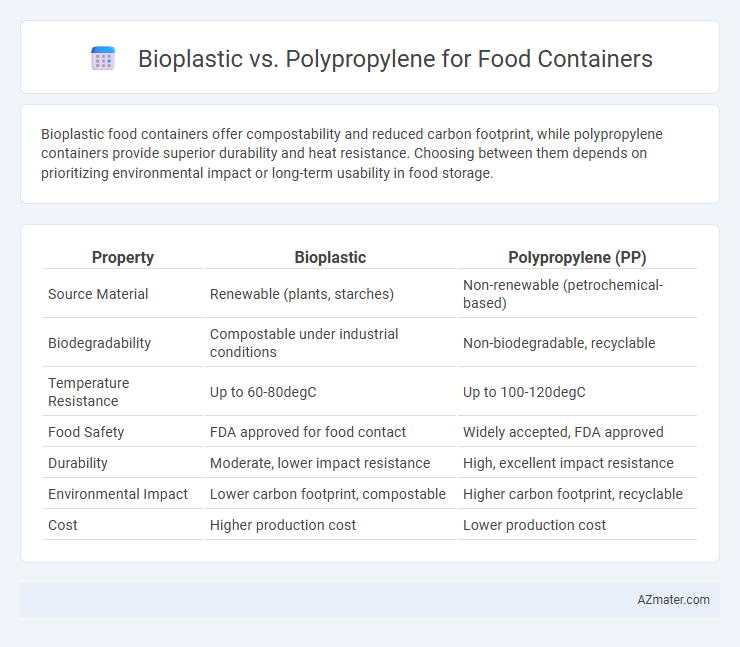Bioplastic food containers offer compostability and reduced carbon footprint, while polypropylene containers provide superior durability and heat resistance. Choosing between them depends on prioritizing environmental impact or long-term usability in food storage.
Table of Comparison
| Property | Bioplastic | Polypropylene (PP) |
|---|---|---|
| Source Material | Renewable (plants, starches) | Non-renewable (petrochemical-based) |
| Biodegradability | Compostable under industrial conditions | Non-biodegradable, recyclable |
| Temperature Resistance | Up to 60-80degC | Up to 100-120degC |
| Food Safety | FDA approved for food contact | Widely accepted, FDA approved |
| Durability | Moderate, lower impact resistance | High, excellent impact resistance |
| Environmental Impact | Lower carbon footprint, compostable | Higher carbon footprint, recyclable |
| Cost | Higher production cost | Lower production cost |
Introduction to Food Container Materials
Bioplastic and polypropylene are two prominent materials used for food containers, each offering distinct environmental and functional properties. Bioplastics are derived from renewable biomass sources such as corn starch or sugarcane, providing compostability and reduced carbon footprint, whereas polypropylene is a petroleum-based polymer known for its durability, chemical resistance, and heat tolerance. Understanding the lifecycle impact, biodegradability, and performance characteristics of these materials is critical for selecting sustainable and food-safe packaging solutions.
What is Bioplastic?
Bioplastic is a type of biopolymer derived from renewable biomass sources such as corn starch, sugarcane, and cellulose, designed to reduce reliance on fossil fuels and decrease environmental impact. Unlike traditional polypropylene, which is petroleum-based, bioplastics can be biodegradable or compostable, offering a sustainable alternative for food containers. Their use in food packaging supports waste reduction and aligns with the growing demand for eco-friendly and sustainable materials in the food industry.
What is Polypropylene?
Polypropylene is a thermoplastic polymer widely used in food containers due to its high heat resistance, durability, and chemical inertness, making it safe for microwave use and dishwasher cleaning. Its lightweight and moisture-resistant properties help preserve food freshness while preventing contamination. Compared to bioplastics, polypropylene offers superior mechanical strength and longer shelf life, though it is derived from non-renewable fossil fuels.
Manufacturing Process Comparison
Bioplastic food containers are typically produced through fermentation of renewable biomass like corn starch or sugarcane, followed by polymerization, resulting in a biodegradable and compostable material. Polypropylene containers use a petroleum-based polymerization process involving propylene gas polymerization under controlled heat and pressure, creating a durable and heat-resistant plastic. The bioplastic manufacturing process emphasizes sustainability and reduced carbon emissions, while polypropylene production focuses on cost-effectiveness and material strength.
Biodegradability and Environmental Impact
Bioplastic food containers offer superior biodegradability compared to polypropylene, breaking down naturally within months under industrial composting conditions, significantly reducing landfill waste. Polypropylene, a petroleum-based plastic, persists in the environment for hundreds of years, contributing to microplastic pollution and increased carbon emissions during production. Choosing bioplastics can lower the environmental footprint of food packaging by minimizing non-renewable resource use and promoting circular waste management systems.
Food Safety and Chemical Resistance
Bioplastic food containers, typically made from plant-based materials like PLA or starch, offer a safer alternative by minimizing the risk of harmful chemical leaching compared to traditional polypropylene (PP) containers. Polypropylene is known for its excellent chemical resistance, effectively preventing contamination from acids, alkalis, and oils during food storage. However, bioplastics have improved food safety profiles by being compostable and free from BPA, making them increasingly popular in sustainable packaging without compromising chemical resistance significantly.
Performance and Durability
Bioplastic food containers, often made from polylactic acid (PLA), offer compostability but typically exhibit lower heat resistance and mechanical strength compared to polypropylene (PP) containers. Polypropylene containers provide superior durability, with excellent impact resistance, high melting points around 160degC, and strong barrier properties suited for extended food storage and microwave use. While bioplastics prioritize environmental benefits, polypropylene remains the preferred material for performance-driven applications requiring long-lasting, heat-stable food containers.
Cost Analysis: Bioplastic vs Polypropylene
Bioplastic food containers typically have a higher initial production cost compared to polypropylene due to raw material expenses and processing technologies. Polypropylene remains more cost-effective for large-scale manufacturing with lower per-unit prices and established supply chains. Long-term cost analysis favors polypropylene as it offers durability and recyclability, reducing overall lifecycle expenses despite bioplastics' environmental benefits.
Consumer Preferences and Market Trends
Consumer preferences are increasingly shifting toward bioplastic food containers due to growing environmental awareness and demand for sustainable packaging. Market trends indicate a rising adoption of bioplastics, driven by regulatory support and enhanced biodegradability, while polypropylene remains popular for its durability and cost-effectiveness. The balance between eco-friendly appeal and performance features shapes purchasing decisions in the food container industry.
Future Outlook for Food Container Materials
Bioplastics are expected to experience significant growth as food container materials due to increasing consumer demand for sustainable and biodegradable options that reduce plastic pollution. Polypropylene remains widely used because of its durability, heat resistance, and cost-effectiveness, but concerns about environmental impact are driving innovation toward bio-based and compostable alternatives. Future developments will likely focus on improving the performance, scalability, and recyclability of bioplastics to meet regulatory pressures and sustainability goals in the food packaging industry.

Infographic: Bioplastic vs Polypropylene for Food Container
 azmater.com
azmater.com